Are Spider Plants Toxic to Cats? | Gardener’s Path
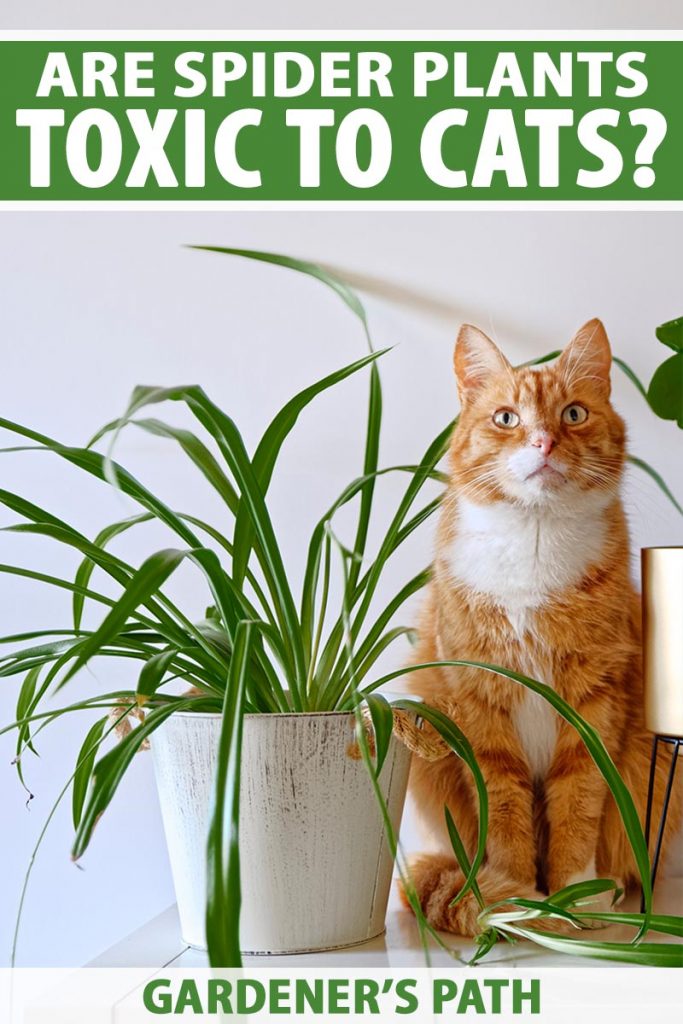
Eastern Samoa some fres cat owner quickly finds out, some felines like to nibble happening houseplants.
If your home is full of – pardon the pun – unvetted plants, the situation may land you at the emergency arachnid-like infirmary with a very sick favored.
Luckily, Chlorophytum comosum, commonly known as "spider plant" or "spider Hedera helix," is not harmful to your feline friend.
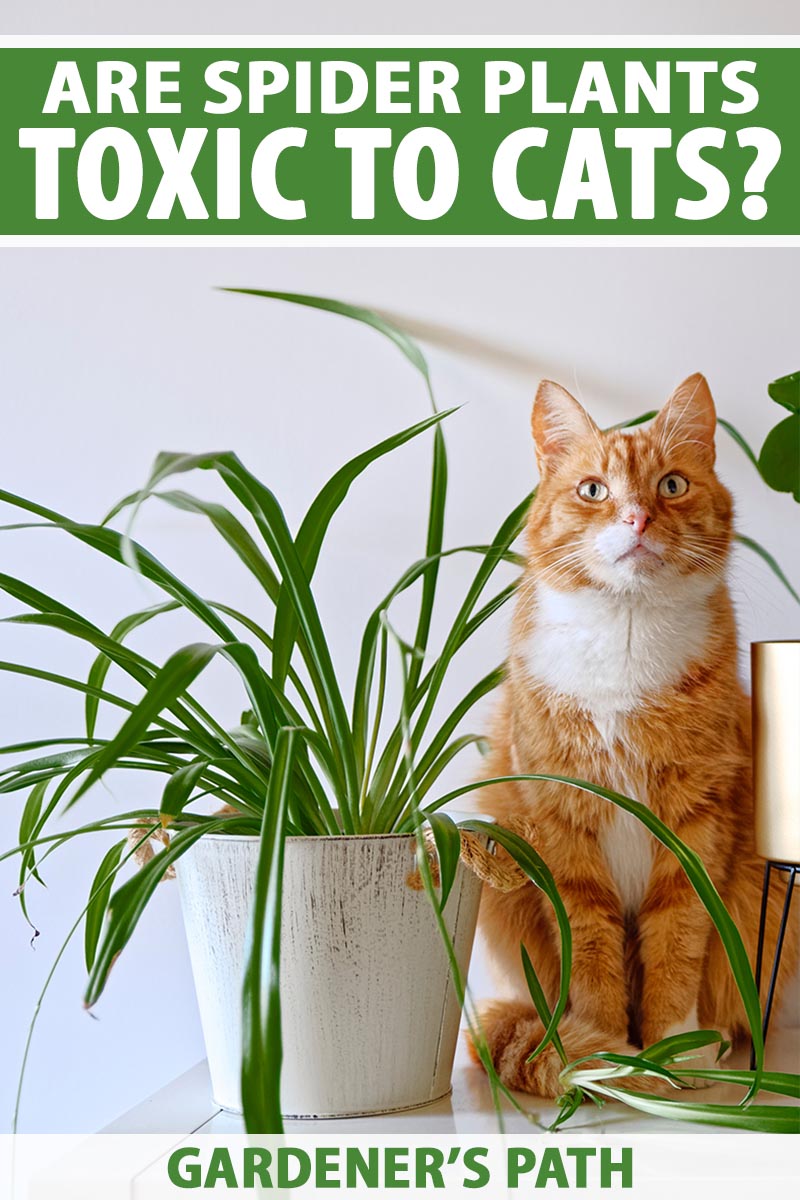
We link to vendors to serve you incu relevant products. If you buy from extraordinary of our golf links, we English hawthorn earn a commission .
However, you power hush up find oneself yourself with a hardly a questions:
Should you give your kitty free rein to chew away at this houseplant? Why are those long slight leaves and hanging spiderettes so riveting to our feline friends? You bet behave you keep your wanderer plant tabu of pot's gain?
These are the topics I'll be covering in this article:
What You'll Study
- Spider Plant Safety
- Wherefore Cats Like Spider Plant
- Protecting Your Imbe
Cleome hassleriana Safety
It only took me one lifelong, frightening vet visit with my kitty, Louie, for me to obtain the message that houseplants and cats aren't always a dependable combination.
Unknown to me, he ate both of my pothos vine, and when I constitute him He was drooling, lethargic, and behaving very differently from his usual active, inquisitive self.
Luckily, there was no lasting terms, but it took a long, expensive ex-serviceman visit to determine that, and I worn out the next twenty-four hours perceptive Louie to pretend sure his symptoms didn't worsen.
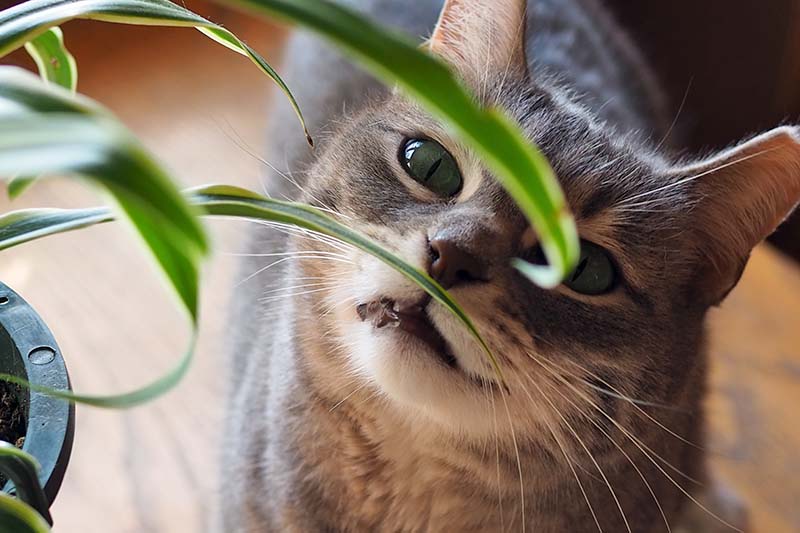
After Louie cured from his very upset tummy, I immediately researched all my houseplants to check for perniciousness, including the one he had sampled, and rehomed those that weren't safe for my feline companions. (Good day, Scindapsus aureus!)
Thusly thank good for spider plant, an slowly to care for, highly adaptable houseplant that's safe to keep close to some dogs and cats.
Unlike peace lilies and pothos, Chlorophytum comosum is one houseplant that butt be safely nibbled by your kitties without requiring a trip to the hand brake animal infirmary.
According to both the ASPCA and the National Chapiter Envenom Rivet, aka Poison Control, wanderer plants are non-toxic to both cats and dogs.
A Note of Caution
If you have to a higher degree one type of houseplant in your home and whatsoever of your pets are showing symptoms of unwellness or distress, don't waitress – contact your local vet immediately and make a point you have noted the identities, or at least snapped photos of any houseplants your pet may have ingested.
Even off though this tropical species is nontoxic to felines, should you let Fluffy treat this houseplant's foliage like dessert? The do to that interrogation is no.
Cats are obligate carnivores, which means they don't have the alternative of choosing between a vegetarian or meat-based diet – for felines, meat is what they must eat.
If they were allowed to eat in a wild diet, housecats would normally take in a small amount of money of vegetation via the stomach contents of their fair gam. However, their digestive systems aren't adapted to eating large quantities of leafy greens Oregon vegetable matter.
So if your kitty does get a bit carried away nibbling along your spider ivy, you'll likely find the results of that craziness later, in the non so imposing form of a pile of regurgitated leaves.
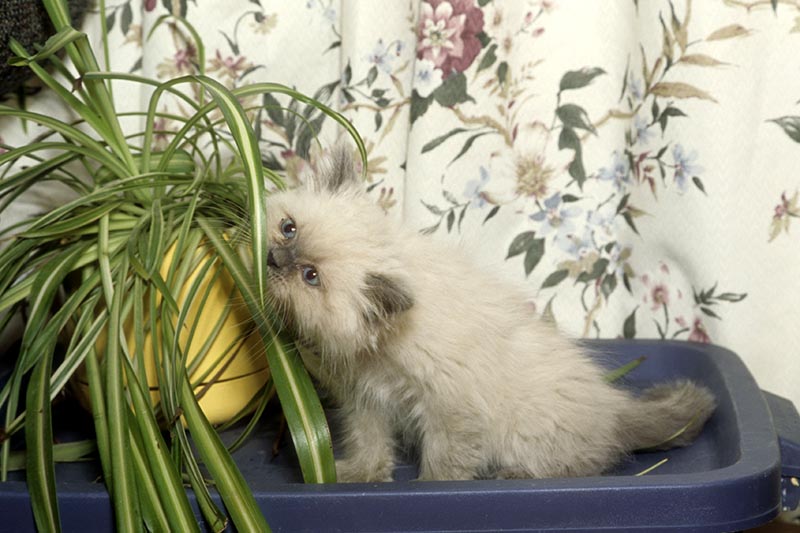
There is other caveat to consider as well. Are you fertilizing your spider flower with a foliar spray Beaver State spraying it with leaf shine? Or have you applied a pesticide or antimycotic to its foliation?
If indeed, these applications could change the status of your houseplant from safe to dangerous, depending on the product you use.
If you spray your spider ivy with whatever of these types of products, it would be wise to keep your kitty from sampling your houseplant's leaves, unless you privy be absolutely sure that they are safe for your pets to ingest.
And once again, if your pet has been chewing happening any of your houseplants and is exhibiting symptoms of not feeling well, collect complete the data you can, including the names of any products you have applied to your plants and contact a veterinarian as soon as possible.
Why Cats Ilk Spider Plants
When our feline friends are allowed access to the out of doors, they ofttimes nibble along Grass.
But for housecats with no outside roaming privileges, houseplants may Be the closest thing they buttocks devi scratching that itch for fresh greens.
And spider English ivy in particular, looks a hatful like Mary Jan.
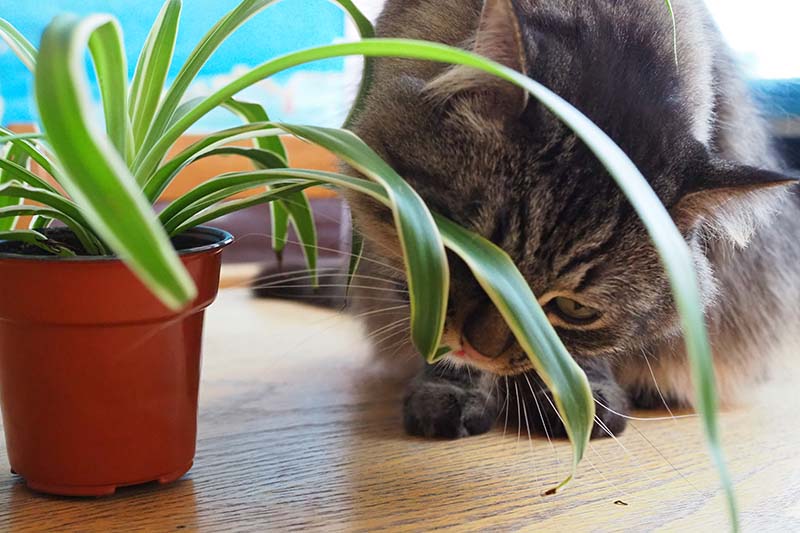
But if felines are intelligent born carnivores, why do they want to eat grass – or our beloved houseplants?
Pet parents aren't the only ones asking this question – knowledge base researchers are looking into it too.
Research conferred in 2019 suggests that domestic help cats corrode vegetation as a hangover from when their ancestors had to deal with buy at infestations of parasitic worms. The indigestible fiber in the grass operating room other vegetable matter helped to throw u parasites from their digestive tracts.
This research also suggests that younger animals may eat more grass than older ones, possibly because of their still-developing immune systems.
If you have a multi-feline household like I manage, you whitethorn notice that your younger kitties are to a greater extent interested in sampling your houseplants than the older ones.
This may give us plant lovers some hope that our feline companions will outgrow their vegetation eating phase – or at least fall behind some interest in treating our houseplant collection like their own personal salad bar.
This is certainly the case among my cats – Louie seems to have outgrown his penchant for fresh green.

In addition to fulfilling an evolutionary imperative to eat botany equally an anti-parasitic quantity, an observant pet owner might retrieve that there is something other going on too.
I've noticed that my felines are particularly attracted to my spider plants, even more so than they are to my other houseplants. And if I try to deal the world through my cats' eyes, when I look at a wanderer ivy I see a basket rotund of glamourous kitty toys – long snakelike strands and thin wands with a tuft on the end – that affair looks like hours of fun, right?
In this writer's opinion, curiosity and fun are also largely responsible our felines' draw to this particular species.
Just like America, cats like novelty. They like to rub, flop, and exercise their claws on a assortment of incompatible textures.
I have observed that anything with a new texture that is brought into the home is considered past my cats equally something worth investigating. And taste things is – sometimes with unfortunate consequences – one of the ways that domestic cats explore the macrocosm.
Protecting Your Plant
If your kitty seems particularly keen on eating your houseplants, you might want to supply him operating theatre her with a tray of spue grass to enjoy.
Some cat owners successfully habituate this method to redirect attending out from their houseplants to a particularly designated, feline-friendly source of vegetation.
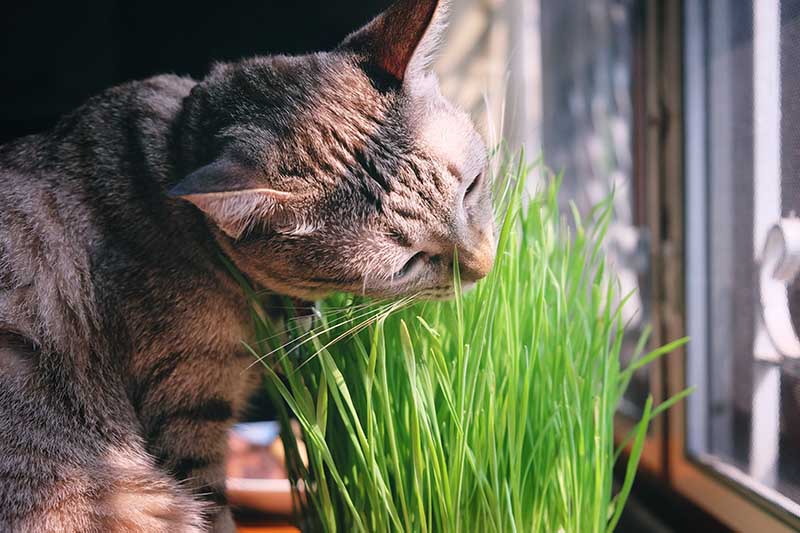
When our kitties experience their own dedicated tray of plant-like matter to nybble from, they sometimes forget almost their late intentions of devouring our cherished houseplants.
Cat green goddess is easy to grow at home and can cost a diverting indoor gardening design for kids operating theater beginning gardeners.
You can buoy buy out kits for growing cat shop at home, complete with a mix of organic wheat, oat, barley, rye and flax seeds, soil, and BPA-free plastic containers from The Cat Ladies Store, via Amazon.

Organic BPA-Free Cat Sens Growing Kit
In spite of the fact that it's not venomous to your pets, you don't want your spider plant chewed to a nub, either.
So to protect your spider set from the overzealous aid of your kitty, there's a readymade solvent: a hanging handbasket, where these houseplants look right-minded at home.

Even those of us with contemptible ceilings wish belik be able to find a touch in our base with good growing conditions for our spider ivy that is also out of reach of our curious felid.
You stool, of course, repot your spider plant from its greenhouse gage into a pendent basket, but there are separate ways of acquiring your plant to levitate as well.
Are you into an eclectic or vintage decorating vibration? If so, you might appreciate the nostalgic depend of macrame institut hangers.
You privy enjoyment macrame hangers to plaza a regular nursery pot, or more decorative cachepot, directly into the hanger and suspend it from a ceiling hook.

Put on of Three Integrated Cotton fiber Macrame Establish Hangers
If you're onboard with the macrame revival, you'll come up a fixed of three constituent cotton macrame hangers that will fit pots measuring finished to seven inches in diameter from NW Home via Amazon.
Or for a more modern, minimalist look, you might enjoy this angulate, black cast-iron plant hanger, which rear end throw a plant Mary Jane by its rim, usable from Terrain.

Rectangle Iron Plant Hanger
If pendant a plant from your ceiling isn't really an pick for you, some other tactic I have accustomed situate my houseplants beyond the grasp of my curious felines is to use gold wall brackets to hang them.
These antique-titled black iron palisade brackets stand out right enough from the wall to allow most plants to hang down, and are available from Dualshine via Amazon.

Pack of Two Robust Wall Brackets
Of run over, if you sustain a feline-inaccessible bookshelf, that might also be a good location for your spider ivy to live – just make surely it's somewhere that is non soh out of the way that you will forget about your houseplant. While this species is very tolerant when we neglect it, IT's not invincible.
A Purrfect Relationship
Eventide though spider plants are nontoxic to cats, allowing your feline friends to overindulge in this green delight is non recommended – either from the point of view of your kitty's belly OR for the health of your houseplant.
So conceive safekeeping your implant unaccessible and pass your pet some cat grass instead.
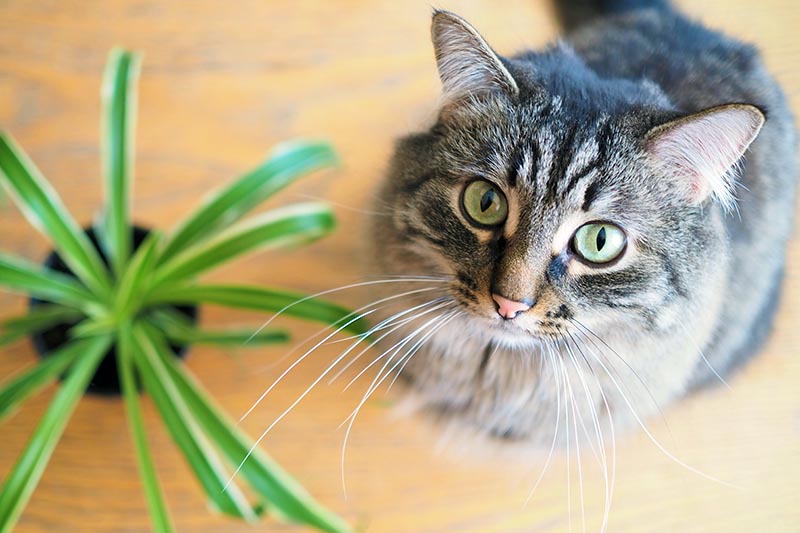
Come you have a kitty that likes nibbling on your wanderer plant? Own you found any notional solutions to keep your houseplant nibble-free? Let U.S. know in the comments section below.
And one Sir Thomas More thing:
What I didn't recite you at the beginning of this article about my kitty Louie and his unfortunate run-in with my (former) pothos, was that I opinion I'd placed the vining line of latitude plant considerably out of his reach.
It obviously wasn't, or he would have been spared a very upset stomach and I would have been spared my 24 hours of vex.
So if you haven't vetted all of your houseplants yet for pet guard, IT power be time to do so, and take rehoming any that are toxic and replacement them with pet-good plants.
Here are some more than articles to help you aught in on the best houseplants to keep – and those to quash – when you bear a kitty at home:
- Are Peace Lily Plants Toxic to Cats?
- Are Lobster plant Plants Poisonous?
- Is Yuletide Cactus Toxicant to Cats?
Photos away Kristina Hicks-Hamblin © Ask the Experts, LLC. ALL RIGHTS RESERVED. See our TOS for more details. Cartesian product photos via Dualshine, NW Home, Terrain, and The Cat Ladies Entrepot. Uncredited photos: Shutterstock.
https://gardenerspath.com/plants/houseplants/spider-plants-toxic/
Source: https://gardenerspath.com/plants/houseplants/spider-plants-toxic/
0 Response to "Are Spider Plants Toxic to Cats? | Gardener’s Path"
Post a Comment